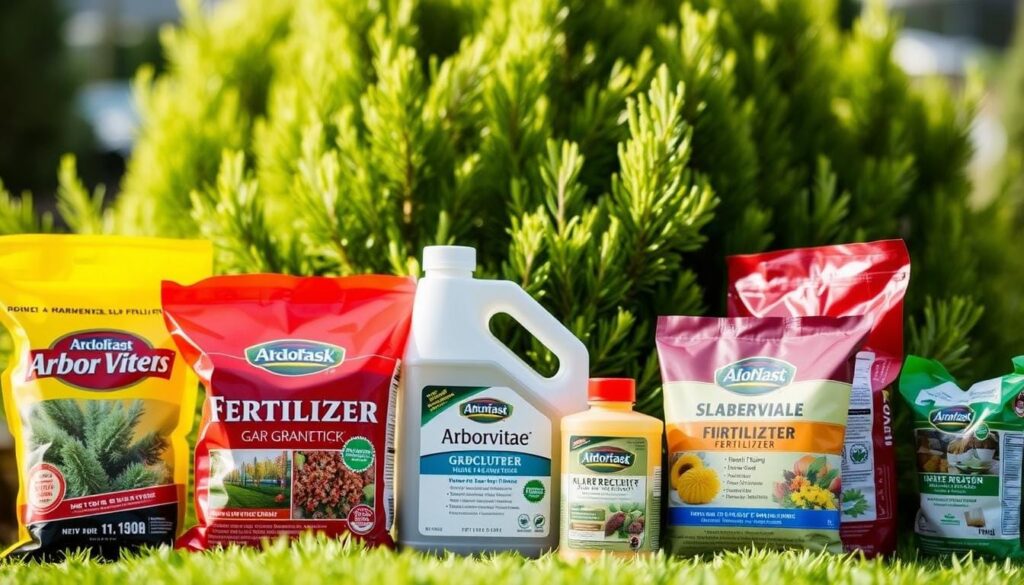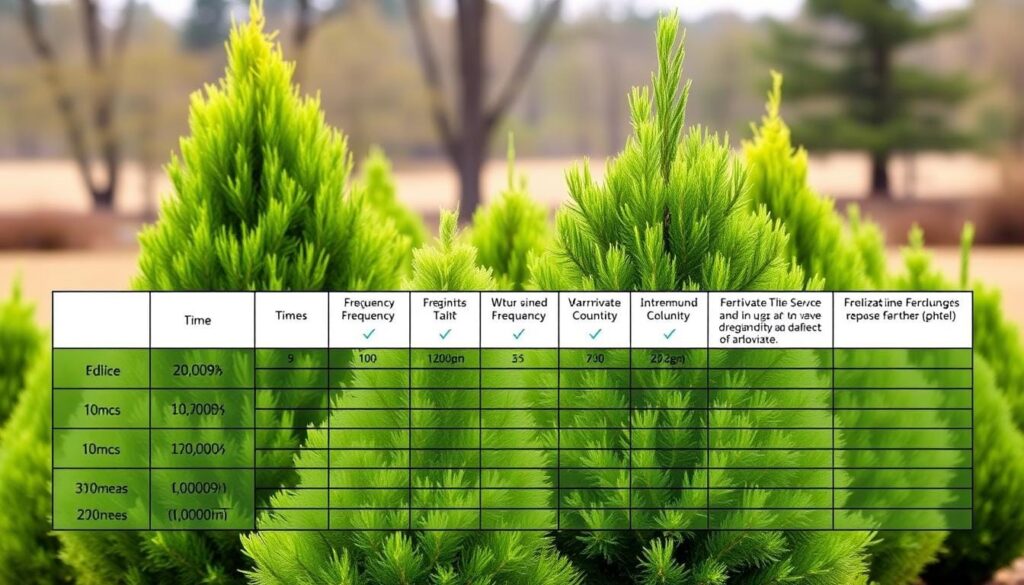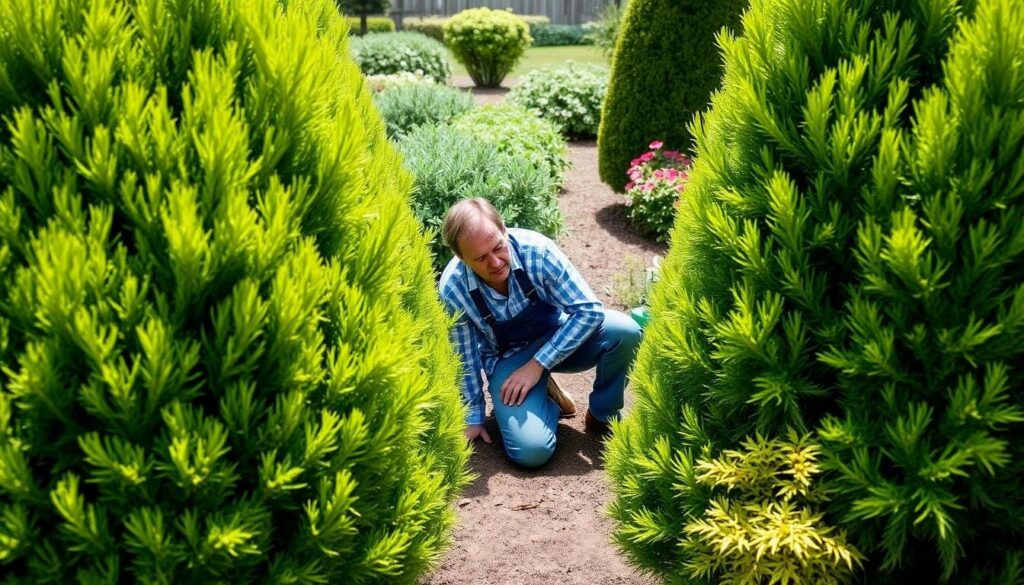There’s nothing quite like the quiet elegance of a thriving arborvitae hedge or tree in your landscape. But what if its needles turn brittle, or growth slows? Many gardeners face this struggle, unsure how to revive these evergreens. Proper fertilization isn’t just about feeding soil—it’s about nurturing living plants that deserve care.
The right fertilizer for arborvitae nutrients can transform weak branches into lush, resilient greenery. Let’s explore how to choose the best fertilizer for arborvitae to ensure your trees thrive.
Key Takeaways
- Arborvitae thrive with balanced fertilizers tailored to their nutrient needs.
- Soil pH directly impacts how arborvitae absorb essential nutrients.
- Over-fertilizing risks burning roots and stressing plants.
- Seasonal timing affects fertilizer effectiveness for arborvitae.
- Organic and synthetic options both have roles in maintaining tree health.
This guide will clarify how the best fertilizer for arborvitae supports growth, addresses common challenges, and prevents mistakes. By understanding arborvitae nutrients and their soil needs, you’ll discover solutions to keep these evergreens vibrant year-round.
Understanding Arborvitae Nutritional Needs
Arborvitae trees do well when their nutritional and soil needs are met. Knowing which arborvitae nutrients and arborvitae soil amendments are key is the first step. These trees need balanced nutrition to keep their leaves green and their roots strong.
Essential Nutrients for Healthy Growth
Arborvitae need nitrogen (N) for leaves, phosphorus (P) for roots, and potassium (K) for stress. A 12-6-6 NPK ratio fertilizer is often best. Iron and manganese are also important to prevent yellow needles. Arborvitae nutrients must be in the right amounts in the soil.
Importance of Soil pH
Soil pH affects how nutrients are absorbed. Arborvitae like slightly acidic to neutral soil (6.0–7.0). If the soil is too acidic or alkaline, it can block nutrients, causing slow growth. Testing kits can show pH imbalances, helping you add lime or sulfur as arborvitae soil amendments.
How to Test Soil for Fertilizer Needs
Start with a soil test to check nutrient levels and pH. DIY kits from garden centers give basic info, while labs offer detailed reports. Here’s how to do it:
- Collect samples from different spots around the tree’s roots
- Check moisture levels before testing
- Compare results to what arborvitae need
For more tips, check outthis guideon keeping trees healthy with the right fertilizer.
Types of Fertilizers for Arborvitae
Choosing the right arborvitae shrub fertilizer starts with understanding fertilizer types. Each option offers unique benefits depending on your plant’s needs and your care approach.
Organic vs. Synthetic Fertilizers

Organic options like compost, manure, or bone meal enrich soil naturally. They release nutrients slowly and improve soil structure. Synthetic arborvitae tree food blends, such as NPK fertilizers, provide precise nutrient ratios for quick results. Synthetic versions may cost less upfront but can impact soil health over time.
“Organic fertilizers build long-term soil vitality, while synthetics offer targeted nutrient boosts,” says a USDA plant specialist.
Slow-Release vs. Fast-Release Options
- Slow-release: Gradual nutrient release over months. Ideal for consistent feeding without over-application.
- Fast-release: Immediate nutrient boost for stressed plants. Requires more frequent applications.
Liquid Fertilizers: Pros and Cons
Liquid options work via foliar sprays or root drenches. They’re easy to apply and show quick results but may wash away without mulch. Use sparingly to avoid runoff and soil imbalance.
Recommended Fertilizers for Arborvitae
Choosing the best fertilizer for arborvitae means finding the right match. Look for products that fit your plant’s needs. They should be affordable, easy to use, and good for long-term health.
Top Organic Fertilizers
- Espoma Holly-Tone: It has cottonseed meal and humus. Use ½ cup for every foot of plant height. Prices are $15–$30.
- Jobe’s Organic Fertilizer Pellets: It’s made of bone meal and kelp. Apply it twice a year. Costs $18–$25.
Leading Synthetic Fertilizers
Synthetic fertilizers work fast:
- Scotts EverGreen Fertilizer: It’s a 12-4-8 NPK formula. Use 1 lb for every 100 sq ft. Prices are $18–$25.
- Lesco Turf & Ornamental: It’s a 16-4-8 NPK. Spread it with a spreader. Costs $20–$30 per bag.
Specialty Formulations for Arborvitae
Arborvitae fertilizer spikes offer slow-release nutrients. Place them evenly around the tree base.

| Product | Type | NPK | Price |
|---|---|---|---|
| Jobe’s EverGreen Spikes | Spike | 10-6-6 | $20–$35 |
| Bonide Annual Flower & Bloom | Granular | 12-6-6 | $15–$25 |
Follow the package instructions for the best spacing and depth. You’ll see results in 4–6 weeks.
Fertilization Frequency and Timing
Getting the arborvitae fertilizer schedule right is key to your trees’ health. It’s all about giving them the right amount of nutrients at the right time. Too much or too little can harm their growth. So, it’s important to follow these tips for the best results.

Optimal Seasons for Feeding Arborvitae
- Early Spring: Start with fertilizer when new growth begins to help them grow strong early on.
- Early Fall: A second dose in September helps build up their roots before winter.
- Avoid Late Applications: Don’t fertilize too late, as it can cause new growth that might freeze in winter.
Signs Your Arborvitae Needs Fertilizer
Needles turning yellow or growth that’s sparse are signs they need more nutrients. If your arborvitae is growing slower than others, it might need more nitrogen. For ongoing problems, it’s best to talk to experts—Chikus Garden explains how diseases can look like nutrient issues.
Calculating Application Amounts
For each foot of your tree, use ½ cup of fertilizer rich in nitrogen. If your tree is young or stressed, double this amount. Make sure to water well after applying to prevent damage to the roots. Adjust the amount based on what your soil test says to avoid overfeeding.
Application Methods for Fertilizer
Proper application ensures the best fertilizer for arborvitae delivers nutrients effectively. Follow these steps to maximize growth and avoid damage.
Granular Fertilizer Application
Use arborvitae plant care best practices for granular options:
- Broadcast Method: Spread fertilizer evenly around the tree, avoiding direct contact with bark. Cover root zones 1–3 feet beyond the canopy edge.
- Band Application: Create shallow trenches 6–12 inches from the trunk, apply fertilizer, and refill trenches.
- Drill Technique: Use a spreader to place pellets in holes drilled 12–18 inches apart under the canopy.

Liquid Fertilizer Techniques
Liquid options require precise tools:
- Calibrate sprayers to match fertilizer dilution ratios on the label.
- Soil drench: Pour diluted solution evenly under the canopy, watering afterward to soak roots.
- Foliar feeding: Mist leaves lightly in early morning or evening to avoid burn.
Best Practices for Fertilizing
Avoid common errors with these tips:
- Always water soil before application to prevent root burn.
- Wear gloves and eye protection when handling chemicals.
- Rotate application zones yearly to prevent nutrient depletion in one spot.
Store unused fertilizer in sealed containers away from children and pets. Regular arborvitae plant care includes checking for yellowing needles or stunted growth after application to adjust future treatments.
Common Mistakes When Fertilizing Arborvitae
Healthy arborvitae need careful care to grow well. Stay away from these mistakes to keep them strong:

Over-Fertilization Risks
Too much arborvitae nutrients can hurt the roots. It causes burns and builds up salt. This weakens the plant, making it easy for pests and diseases to attack.
Look out for yellow needles or slow growth. If you see these signs, cut back on the fertilizer slowly.
Ignoring Soil Quality
Soil health is key, not just fertilizer. Bad soil or the wrong pH (too low or too high) stops plants from getting what they need. Test your soil before adding fertilizer.
Poor soil can ruin even the best arborvitae plant care. Fix soil problems before you fertilize.
Misunderstanding Growth Stages
New plants don’t need a lot of nitrogen to avoid root damage. Older plants need less than younger ones. Change your fertilizer based on the plant’s age.
Use slow-release fertilizers for grown trees. For new plants, choose low-nitrogen blends.
Signs of Nutrient Deficiency in Arborvitae
Spotting nutrient deficiencies early is key to your arborvitae’s health. It needs balanced soil and proper care. Look for signs like yellow leaves or slow growth to act fast. Tools like soil testers or visual guides help find the right nutrients.
Yellowing Foliage: Causes and Solutions
- Uniform yellowing: This usually means a lack of nitrogen. Use a fertilizer with more nitrogen.
- Yellow veins with green leaves: This is iron chlorosis. Try chelated iron sprays or soil amendments.
- Tip browning: This could be due to potassium shortage. Choose formulas with more potassium to boost health.
Stunted Growth Indicators
Slow growth or thin branches show deeper problems. Phosphorus issues affect roots, while micronutrient gaps slow cell growth. Use arborvitae growth enhancers with trace elements like zinc or manganese to help.
- Reduced shoot length year-over-year
- Weak branch formation
- Thin foliage density
Importance of Regular Monitoring
Keep track of changes every 4-6 weeks with a growth log. Note foliage color, new shoot length, and canopy density. Photos show progress over time. Adjust nutrients based on symptoms. Early action prevents lasting damage and keeps your arborvitae healthy.
Caring for Arborvitae Beyond Fertilization
Healthy arborvitae need more than just food. They also need the right amount of water, regular pruning, and protection from pests. These steps help them grow strong and healthy.
Watering Guidelines
- Water deeply but infrequently—soil should stay moist but not soggy.
- Use drip irrigation systems to target roots; avoid overhead watering in hot weather.
- Reduce watering in winter; adjust frequency based on rainfall and soil drainage.
Pruning Tips for Healthy Growth
Pruning is key for a good shape and air flow. Use clean shears to:
- Remove dead or yellowing branches annually.
- Cut back overgrown tips to encourage dense foliage, paired with an arborvitae growth enhancer for recovery.
- Avoid heavy pruning in late summer to prevent winter damage.
Pest and Disease Management
| Issue | Solution |
|---|---|
| Bagworms | Handpick or treat with insecticidal soap. |
| Spider Mites | Wash foliage with water jets; apply neem oil if persistent. |
| Root Rot | Improve drainage and reduce overwatering; prune affected roots. |
Healthy plants fight off pests better when they’re well-fed. Add pruning and pest control to nutrient-rich soil for lasting health.
Regional Considerations for Fertilizing Arborvitae
Northern and southern climates need special care for arborvitae. Soil and weather changes mean different approaches to keep evergreens healthy all year.
Fertilizer Needs in Northern States
Cold areas have shorter growing seasons and face winter stress. Use slow-release nitrogen-based arborvitae soil amendments to build strong roots before winter. Don’t feed too late to avoid damage to new growth.
USDA zones 3–6 do well with early spring fertilizer and mulch to keep warm.
Southern Climate Adaptations
In zones 7–10, focus on heat and moisture. Adjust arborvitae fertilizer schedules for fall rains, cutting back on summer feeding to avoid burning. Sandy soils might need iron to stop nutrient loss.
Factors Influencing Fertilization in Different Zones
Soil types and microclimates need zone-specific plans. Urban areas might need less nitrogen to prevent pollution. Rural areas could face pests that affect feeding times.
| USDA Zone | Key Soil Issue | Recommended Amendments | Fertilizer Schedule |
|---|---|---|---|
| 3–6 | Clay compaction | Composted bark | Early spring only |
| 7–9 | Salt exposure | Calcium-rich mulch | Biannual (fall/spring) |
| 10+ | Low organic matter | Coconut coir blends | Year-round light feeding |
Test soil pH every year to adjust nutrients. Coastal gardeners should watch for salt buildup. Mountainous areas might need winter protection, even with good feeding.
Organic Practices for Arborvitae Care
Starting a sustainable garden means using organic ways to care for arborvitae. These methods help the soil stay healthy for a long time. They also make plants stronger and less dependent on arborvitae shrub fertilizer.
Benefits of Composting
Composting turns kitchen waste and yard clippings into arborvitae soil amendments. Start by mixing fruit peels, shredded leaves, and grass clippings in a bin. Every month, turn the pile to keep it aerated. In spring, spread the finished compost around the arborvitae to slowly release nutrients.
Using Natural Mulches
Opt for mulches that help the soil naturally:
- Pine needles: They add an acidic touch, like arborvitae’s natural home.
- Cedar chips: Keep insects away and hold moisture in.
- Leaf mold: It breaks down into organic matter, improving soil structure.
Apply 2-3 inches of mulch every year. Make sure it’s 2 inches away from the plant base.
Companion Planting Techniques
Pairing plants wisely can boost arborvitae health:
- White clover: It fixes nitrogen in the soil, cutting down on fertilizer needs.
- Marigolds: Their scent keeps pests away.
- Juniper: It helps with drought by sharing root zone benefits.
Keep companion plants 18-24 inches away from arborvitae to avoid root competition.
Safety Tips for Fertilizer Use
Using arborvitae tree food or arborvitae fertilizer spikes safely means following labels and storing properly. This keeps everyone and the environment safe.
Understanding Fertilizer Labels
Always read labels before you start. Look for NPK ratios and how much to use on arborvitae tree food or fertilizer spikes. Also, check for warnings about pests or harm to the environment. Here are some details to look for:
- Nitrogen (N), Phosphorus (P), and Potassium (K) percentages
- Guaranteed analysis of micronutrients
- Instructions for mixing or placement
Safe Storage Practices
Store unused arborvitae fertilizer spikes and tree food safely. Here’s how:
- Keep in original containers with intact labels
- Lock cabinets to prevent access by children or pets
- Store in dry areas to avoid clumping or degradation
Environmental Considerations
“Protecting watersheds starts with responsible fertilizer use.” — USDA Plant Health Institute
Apply arborvitae tree food when it won’t rain. Don’t spread near streams or drains. Use slow-release fertilizer spikes to reduce waste. Adjust timing to meet tree needs without overdoing it.
Conclusion: Finding the Right Fertilizer for Your Arborvitae
Arborvitae do best with a fertilizer plan that meets their needs. The best fertilizer for arborvitae has the right mix of nutrients and pH balance. This supports their growth. It’s important to consider your local climate, the age of your trees, and what you want them to do, like being privacy screens.
Tailoring Fertilization to Your Specific Needs
Every arborvitae is different, and so is every environment. Begin by checking your soil’s health and picking a fertilizer that matches. Slow-release fertilizers or arborvitae growth enhancer products are good for steady nutrient delivery. Adjust how often you apply it based on your area’s climate and the seasons.
Ongoing Care for Optimal Results
Arborvitae need ongoing care to stay healthy. Watch how they grow and if their leaves are the right color. Don’t overdo it with nitrogen, as it can hurt their roots. Test your soil every 1-2 years to make sure you’re on track. Also, keep an eye out for diseases like root rot and act fast if you see any signs.
Learn more about keeping your trees healthy here.
Final Recommendations for Best Practices
Choose slow-release fertilizers to prevent too much of a good thing. Apply in early spring or fall, when it’s cooler. Mulch helps keep the soil moist and at a good temperature. Make sure to water and prune them right to help them grow a full canopy. Focus on giving them balanced nutrients to help them fight off pests and handle stress.

